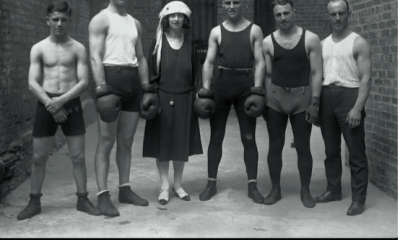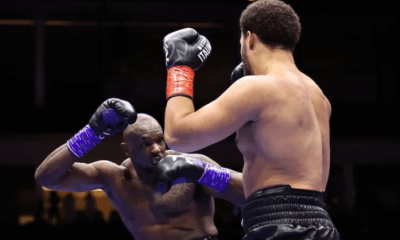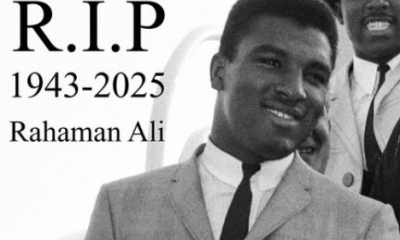Articles of 2006
Luther “Slugger” White: Not seeing is believing
In the 1940s plenty of excellent African-American boxers never got the opportunities and recognition they deserved. But in the April 1942 issue of The Ring magazine, editor-publisher Nat Fleischer singled out for praise six “colored lads” who, he said, “had come along with flying colors” in the welterweight and lightweight ranks over the previous 10 months.
They were Sugar Ray Robinson, Charley Burley, Bob Montgomery, Holman Williams, Jackie Wilson, and Luther “Slugger” White.
Robinson is today widely regarded as the greatest fighter ever to don gloves. Burley is considered by many the best fighter never to win a title. Bob Montgomery became world lightweight champion and, like the previous two, an inductee into the International Boxing Hall of Fame. Another uncrowned champion, Holman Williams defeated Burley and Archie Moore. Jackie Wilson was the 1936 Olympic bantamweight silver medalist and later a top ranked lightweight and welterweight who, like Williams, is enshrined in the World Boxing Hall of Fame.
For some reason boxing has turned a blind eye to the accomplishments of Luther “Slugger” White, who literally did the same thing to most of his opponents during the eight year career that saw White rise as high as the number two spot in the Ring’s 135-pound rankings, and win recognition as lightweight champion in his home base of Maryland.
And who knows, if they’d left the lights out when L.A.’s Gilmore Stadium was hit by an electrical failure during White’s fight with Sammy Angott, it might’ve leveled the playing field enough for the mostly blind fighter to nab the NBA belt.
If that seems totally preposterous, what about a guy who could take out his right eye and play marbles with it but had no trouble passing pre-fight medical examinations?
White’s disability reportedly went back to 1938, but his career had gotten off on the wrong foot a year before that when in his first professional bout the native of Athens, Georgia was stopped in four rounds by the aforementioned Holman Williams. Williams was then a veteran of 44 fights, and was recognized as the ‘Negro Lightweight Champion’ by virtue of his defeat of Baby Tiger Flowers two years before he met White.
White rebounded, and at the end of ‘38 he was 9-3. But in one of those fights he suffered the detached retina that left his right eye completely sightless. The eldest of seven sons renowned as a boy for his ability to pick more cotton than anybody else, Slugger White, who won his nickname felling a cotton field bully, used that same indomitability to keep going in the ring with only one working headlight. Not able to see well enough to box from a distance, he developed into a torrid, crowd-pleasing infighter whose incessant punching style brought to mind triple champion Henry Armstrong, someone, in the words of Nate
Phillips, The Ring’s Maryland correspondent, “who believes a great offense is a good defense, and a good offense is a great defense.”
Future 135-pound champion Montgomery, then ranked sixth as a welterweight by The Ring, won a unanimous decision over White in Baltimore on July 14, 1941, and afterwards said it was the toughest fight he’d ever had.
Baltimore became White’s home ground, where he subsequently beat well regarded Jimmy Leto, Joey Peralta, Dave Castilloux, Jimmy Hatcher, and former featherweight champion Leo Rodak to make Nat Fleischer’s list of ebony wonders. By late 1942, he was “one of the most feared 135-pounders in the country,” according to Ring correspondent Ike Morales, writing from New Orleans where in September White beat Gene Johnson and then, just two weeks later, he met former national amateur lightweight champion Willie Joyce in a 15-round bout for what was billed as the ‘Negro Lightweight Championship.’
Joyce won the decision, but Morales noted “many in the audience who thought
Slugger deserved no less than a draw.”
On January 4, 1943, White and Joyce fought again in Baltimore. After 15 thrilling rounds, the decision went to White, and with it recognition by the Maryland State Athletic Commission as lightweight champion.
Sammy Angott had retired as champion the previous November 13. The powerful
New York boxing commission said nothing doing to Maryland’s idea of White as champion, but invited the Slugger to participate in an elimination tournament to choose Angott’s successor, along with Beau Jack, Tippy Larkin, Allie Stoltz, Cleo Shans, Joey Peralta, Juan Zurita, Bob Montgomery, Maxie Shapiro and Willie Joyce.
Fine, said White’s manager, Sam Lampe, but under one condition: that White be exempted from the mandatory physical exam. Commission Chairman John J.
Phelan naturally demurred, for which Lampe called him so many bad names that
Phelan felt compelled to issue a public statement disclosing rumors about White’s bad eyes. “When informed that [White] would have to go to a dark room for an eye examination,” Phelan said, “White’s manager entrained with his charge for the Pacific Coast, rather than have the truth known.”
In California, White buzzsawed through Jorge Morelia, Jackie Byrd, Vern Bybee, Jose Mendoza, John Thomas, Julio Cesar Jimenez and Juan Zurita. The fights were all savage, with White always punching furiously on the inside and overwhelming his opponents.
Meanwhile, Angott unretired in early ‘43, and on October 27 of that year he and White fought for the National Boxing Association lightweight title at Gilmore Field in Los Angeles. It was the first outdoor show allowed after dark since the attack on Pearl Harbor almost two years before. “The electricians must have been out of practice,” wrote Harry Winkler in The Ring, “as the lighting system went dead just before the fourth round
… and it was over an hour before the bout could be continued.”
It was all Angott, who won the 15-round decision. “The colored buzzsaw was absolutely bewildered by Sammy’s unorthodox tactics,” wrote Winkler. “The champion would continually beat Slugger to the punch … and when Angott elected to wrestle instead of punch he handled White as though he were a rag doll. And at tying ‘em up, well, had Angott been around to tie up Houdini, that great escape artist would have lost his reputation.” They didn’t call Angott “The Clutch” for nothing.
But it surely helped that he was fighting a virtual blind man. By then, White’s left eye was badly deteriorated, too.
In his next fight, White lost a decision to future lightweight champion Ike Williams in Philadelphia. On July 14, 1944, White and Henry Armstrong waged a toe-to-toe war for 10 rounds at Hollywood Legion Stadium that was declared a draw. White then beat Vince Dell’Orto in Baltimore and headed back to the West Coast for a rubber match with Willie Joyce.
The day before the fight, Dr. A. E. Egerton got the shock of his life when, after White correctly read the eye chart during his mandatory physical exam, he looked into the fighter’s eyes with his pen-sized flashlight and discovered that White’s right one was a glassy.
“The patient has an artificial right eye. I would not advise that he be allowed to box because a blow over the left eye would be apt to cause a complete retinal detachment of the left eye and result in blindness,” reported the doc.
The California boxing commission promptly cancelled the Joyce fight, lifted
White’s license, and proclaimed in a statement, “This commission feels that it was through its diligence that White’s true condition was eventually discovered.”
That had them slapping their knees in the press row.
“Slugger White’s been fisticuffing around these parts for years and passing physical examinations with flying colors,” wrote Al Wolf of the L.A. Times. “It had long been rumored that White’s vision was impaired, but the State Athletic Commission and its doctors apparently had been overlooking the minor item of sight in testing the fitness of fighters to fight. Wot a business!”
The Times reported that before the Armstrong fight White was examined and cleared to fight by not one but two commission doctors, prompting columnist Braven Dyer to recommend that the commission look around “for some new authorities on glass eyes.”
White had exchanged his long dead right eye for a glass one five weeks before the Ike Williams fight. At least that’s the story he’d given the draft board doctor when White reported that March for his pre-induction physical with a bandage over his empty eye socket. Given that and the fact that his remaining eye didn’t have much wattage anymore, the Army passed.
Now finally thumbed out of the ring, Slugger White (39-12-3) disappeared and was never heard from again.
That he fought as long and well as he did under the circumstances is mind-boggling, and the electors of one of the sports pantheons out there, even if only the Athletes With Disabilities Hall of Fame, ought to see the light and honor this staunchest of ring warriors.
-

 Featured Articles4 weeks ago
Featured Articles4 weeks agoThe Hauser Report: Zayas-Garcia, Pacquiao, Usyk, and the NYSAC
-

 Featured Articles3 weeks ago
Featured Articles3 weeks agoOscar Duarte and Regis Prograis Prevail on an Action-Packed Fight Card in Chicago
-

 Featured Articles2 weeks ago
Featured Articles2 weeks agoThe Hauser Report: Cinematic and Literary Notes
-

 Book Review2 weeks ago
Book Review2 weeks agoMark Kriegel’s New Book About Mike Tyson is a Must-Read
-

 Featured Articles4 weeks ago
Featured Articles4 weeks agoRemembering Dwight Muhammad Qawi (1953-2025) and his Triumphant Return to Prison
-

 Featured Articles3 days ago
Featured Articles3 days agoThe Hauser Report: Debunking Two Myths and Other Notes
-

 Featured Articles1 week ago
Featured Articles1 week agoMoses Itauma Continues his Rapid Rise; Steamrolls Dillian Whyte in Riyadh
-

 Featured Articles3 weeks ago
Featured Articles3 weeks agoRahaman Ali (1943-2025)















